Element Engineering Australia: Business Model Analysis and Evaluation
VerifiedAdded on 2021/04/17
|11
|2491
|37
Report
AI Summary
This report provides a comprehensive analysis of Element Engineering Australia's business model, focusing on its application in engineering management. It begins with a business description, outlining the company's operations in mechanical engineering and industrial management. The core of the report examines the business model canvas, detailing key partners, activities, value propositions, audience segments, resources, distribution channels, and cost and revenue structures. The analysis explores the interrelationships between the nine building blocks of the business model, highlighting factors that contribute to the company's success, such as product diversification, industrial positioning, and a strong business niche. The report also identifies potential downside risks, including management challenges, project delays, and limited investment. Finally, it suggests potential changes to the business model, such as incorporating modern technology, introducing engineering consultancy services, and focusing on sustainable management practices. The conclusion summarizes the key findings and emphasizes the company's role in the industrial, construction, and mining sectors.
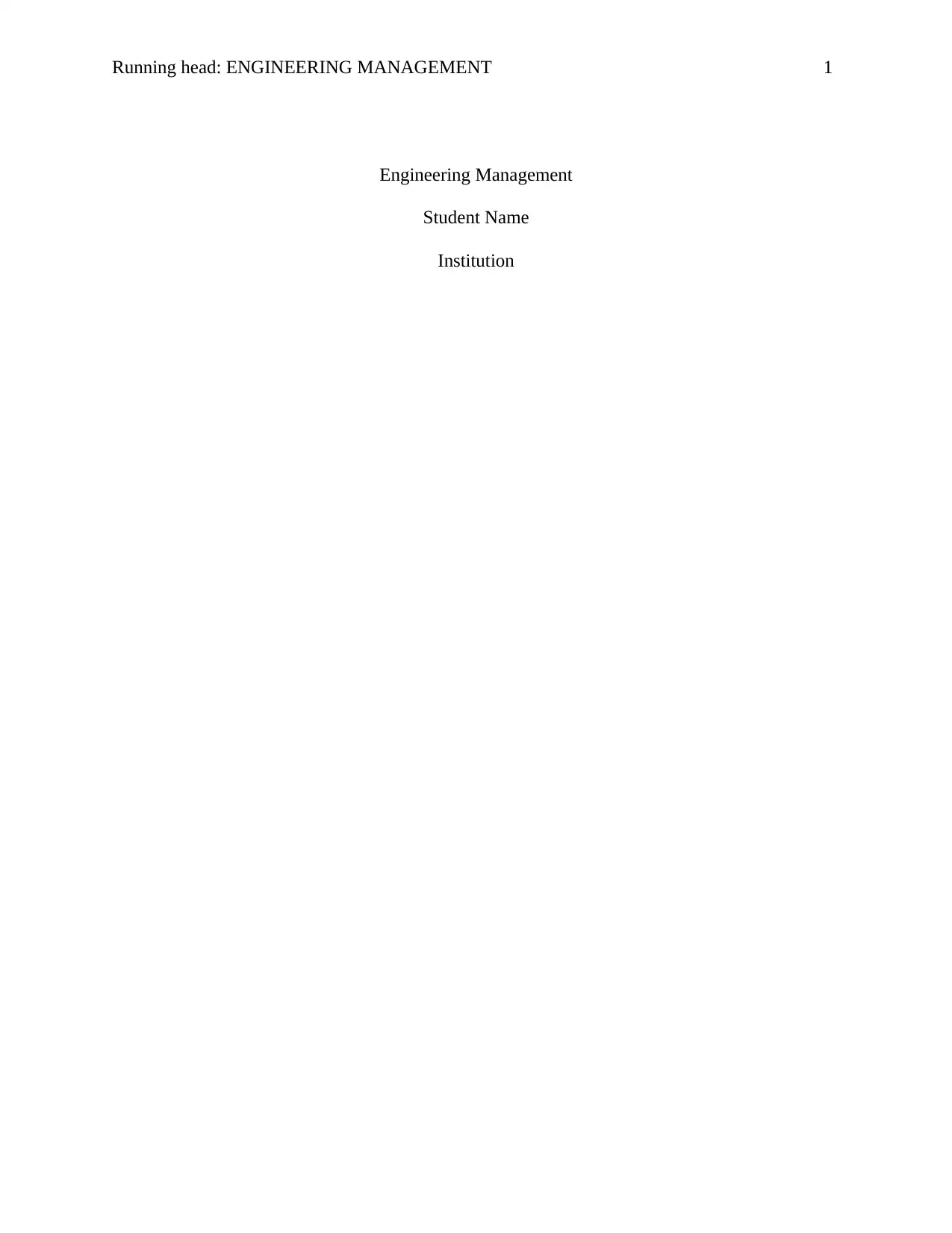
Running head: ENGINEERING MANAGEMENT 1
Engineering Management
Student Name
Institution
Engineering Management
Student Name
Institution
Paraphrase This Document
Need a fresh take? Get an instant paraphrase of this document with our AI Paraphraser
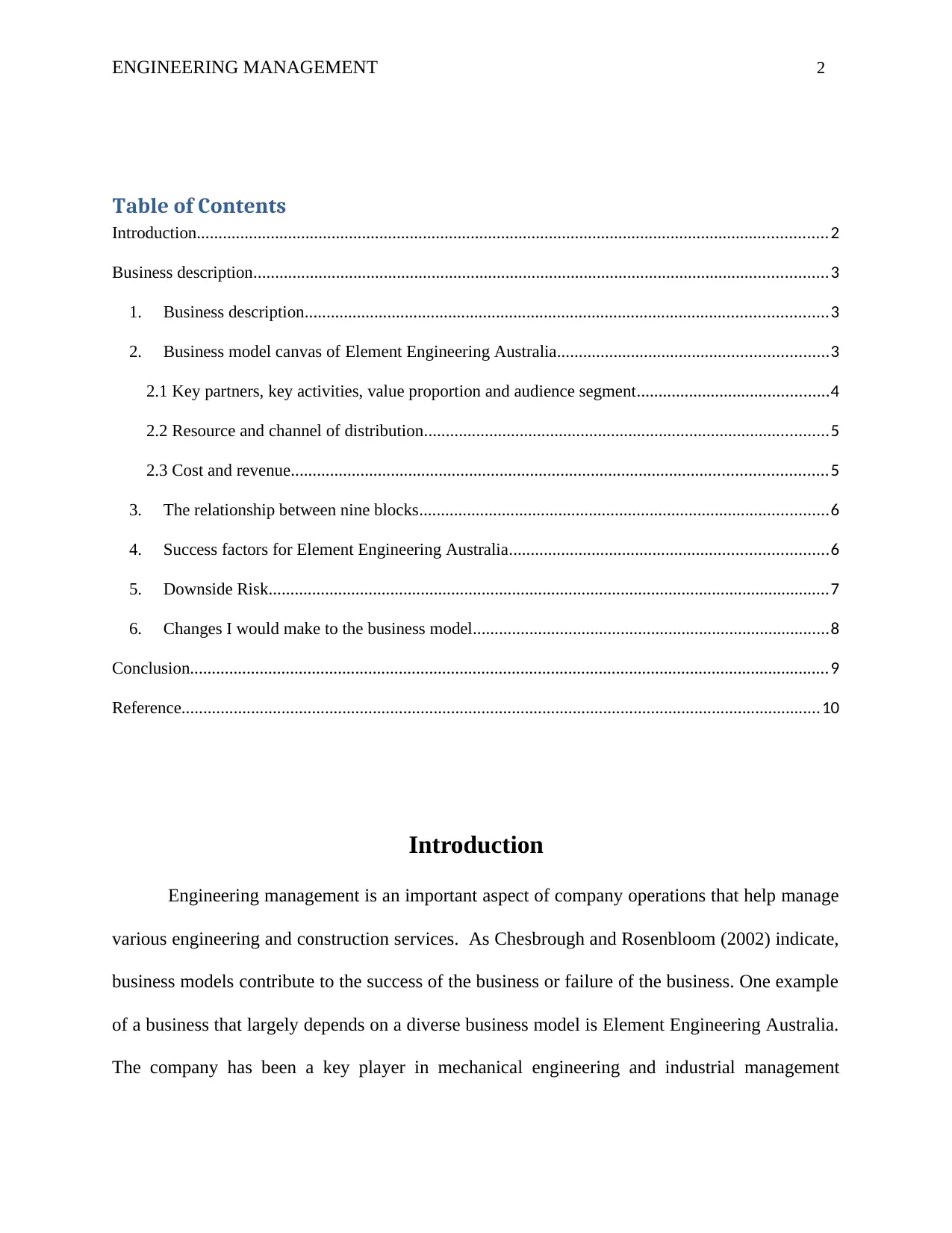
ENGINEERING MANAGEMENT 2
Table of Contents
Introduction.................................................................................................................................................2
Business description....................................................................................................................................3
1. Business description........................................................................................................................3
2. Business model canvas of Element Engineering Australia..............................................................3
2.1 Key partners, key activities, value proportion and audience segment............................................4
2.2 Resource and channel of distribution.............................................................................................5
2.3 Cost and revenue...........................................................................................................................5
3. The relationship between nine blocks..............................................................................................6
4. Success factors for Element Engineering Australia.........................................................................6
5. Downside Risk.................................................................................................................................7
6. Changes I would make to the business model..................................................................................8
Conclusion...................................................................................................................................................9
Reference...................................................................................................................................................10
Introduction
Engineering management is an important aspect of company operations that help manage
various engineering and construction services. As Chesbrough and Rosenbloom (2002) indicate,
business models contribute to the success of the business or failure of the business. One example
of a business that largely depends on a diverse business model is Element Engineering Australia.
The company has been a key player in mechanical engineering and industrial management
Table of Contents
Introduction.................................................................................................................................................2
Business description....................................................................................................................................3
1. Business description........................................................................................................................3
2. Business model canvas of Element Engineering Australia..............................................................3
2.1 Key partners, key activities, value proportion and audience segment............................................4
2.2 Resource and channel of distribution.............................................................................................5
2.3 Cost and revenue...........................................................................................................................5
3. The relationship between nine blocks..............................................................................................6
4. Success factors for Element Engineering Australia.........................................................................6
5. Downside Risk.................................................................................................................................7
6. Changes I would make to the business model..................................................................................8
Conclusion...................................................................................................................................................9
Reference...................................................................................................................................................10
Introduction
Engineering management is an important aspect of company operations that help manage
various engineering and construction services. As Chesbrough and Rosenbloom (2002) indicate,
business models contribute to the success of the business or failure of the business. One example
of a business that largely depends on a diverse business model is Element Engineering Australia.
The company has been a key player in mechanical engineering and industrial management
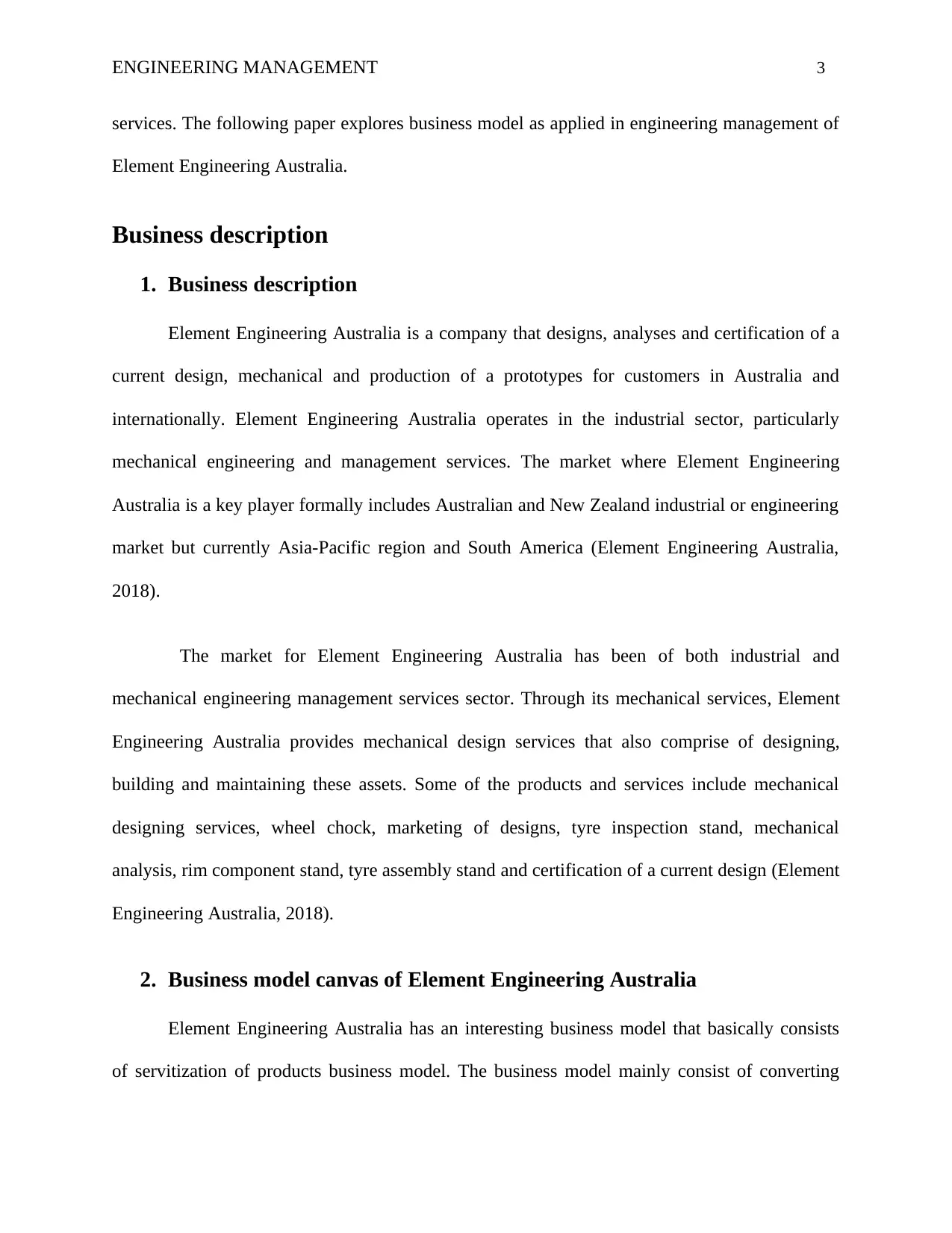
ENGINEERING MANAGEMENT 3
services. The following paper explores business model as applied in engineering management of
Element Engineering Australia.
Business description
1. Business description
Element Engineering Australia is a company that designs, analyses and certification of a
current design, mechanical and production of a prototypes for customers in Australia and
internationally. Element Engineering Australia operates in the industrial sector, particularly
mechanical engineering and management services. The market where Element Engineering
Australia is a key player formally includes Australian and New Zealand industrial or engineering
market but currently Asia-Pacific region and South America (Element Engineering Australia,
2018).
The market for Element Engineering Australia has been of both industrial and
mechanical engineering management services sector. Through its mechanical services, Element
Engineering Australia provides mechanical design services that also comprise of designing,
building and maintaining these assets. Some of the products and services include mechanical
designing services, wheel chock, marketing of designs, tyre inspection stand, mechanical
analysis, rim component stand, tyre assembly stand and certification of a current design (Element
Engineering Australia, 2018).
2. Business model canvas of Element Engineering Australia
Element Engineering Australia has an interesting business model that basically consists
of servitization of products business model. The business model mainly consist of converting
services. The following paper explores business model as applied in engineering management of
Element Engineering Australia.
Business description
1. Business description
Element Engineering Australia is a company that designs, analyses and certification of a
current design, mechanical and production of a prototypes for customers in Australia and
internationally. Element Engineering Australia operates in the industrial sector, particularly
mechanical engineering and management services. The market where Element Engineering
Australia is a key player formally includes Australian and New Zealand industrial or engineering
market but currently Asia-Pacific region and South America (Element Engineering Australia,
2018).
The market for Element Engineering Australia has been of both industrial and
mechanical engineering management services sector. Through its mechanical services, Element
Engineering Australia provides mechanical design services that also comprise of designing,
building and maintaining these assets. Some of the products and services include mechanical
designing services, wheel chock, marketing of designs, tyre inspection stand, mechanical
analysis, rim component stand, tyre assembly stand and certification of a current design (Element
Engineering Australia, 2018).
2. Business model canvas of Element Engineering Australia
Element Engineering Australia has an interesting business model that basically consists
of servitization of products business model. The business model mainly consist of converting
⊘ This is a preview!⊘
Do you want full access?
Subscribe today to unlock all pages.

Trusted by 1+ million students worldwide
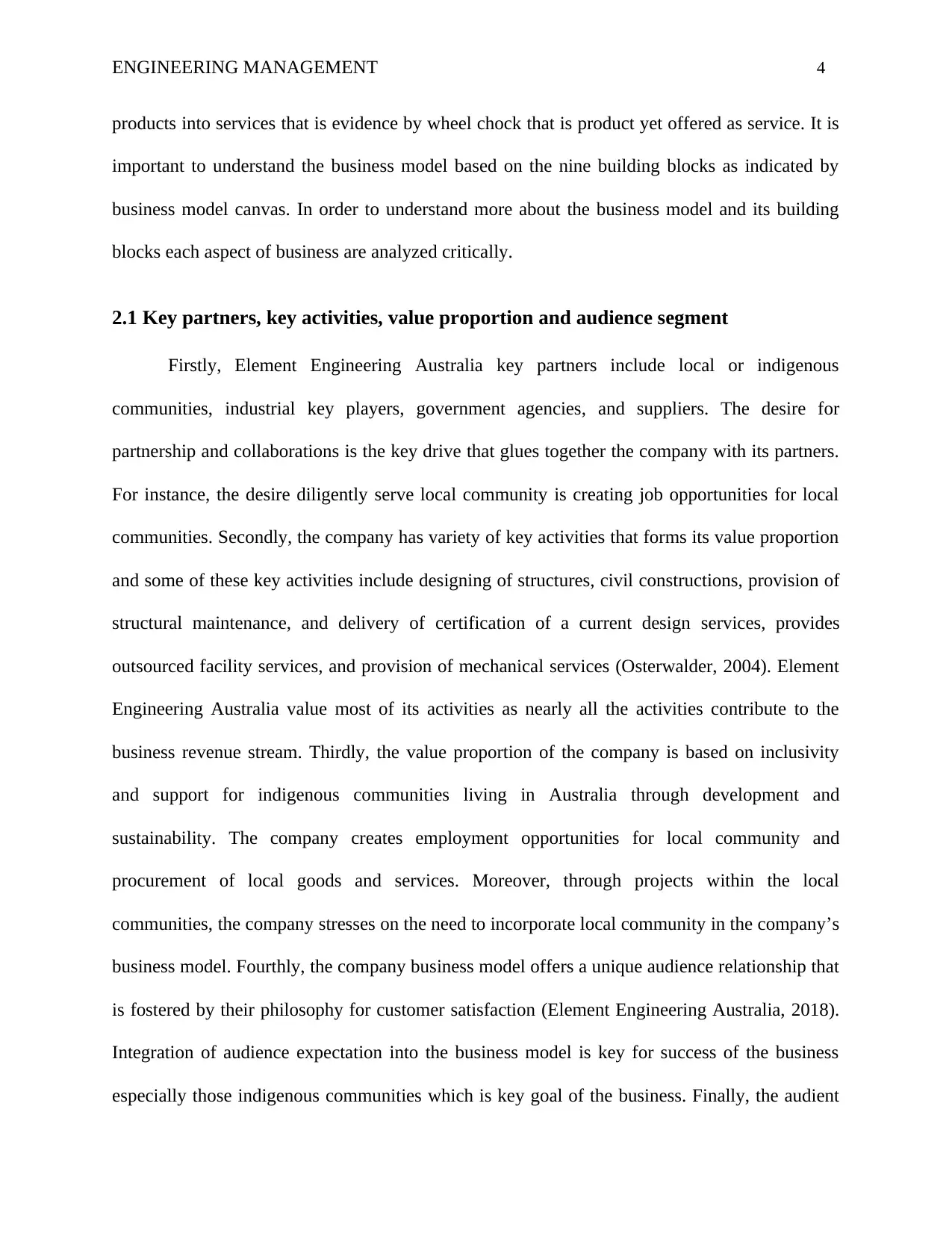
ENGINEERING MANAGEMENT 4
products into services that is evidence by wheel chock that is product yet offered as service. It is
important to understand the business model based on the nine building blocks as indicated by
business model canvas. In order to understand more about the business model and its building
blocks each aspect of business are analyzed critically.
2.1 Key partners, key activities, value proportion and audience segment
Firstly, Element Engineering Australia key partners include local or indigenous
communities, industrial key players, government agencies, and suppliers. The desire for
partnership and collaborations is the key drive that glues together the company with its partners.
For instance, the desire diligently serve local community is creating job opportunities for local
communities. Secondly, the company has variety of key activities that forms its value proportion
and some of these key activities include designing of structures, civil constructions, provision of
structural maintenance, and delivery of certification of a current design services, provides
outsourced facility services, and provision of mechanical services (Osterwalder, 2004). Element
Engineering Australia value most of its activities as nearly all the activities contribute to the
business revenue stream. Thirdly, the value proportion of the company is based on inclusivity
and support for indigenous communities living in Australia through development and
sustainability. The company creates employment opportunities for local community and
procurement of local goods and services. Moreover, through projects within the local
communities, the company stresses on the need to incorporate local community in the company’s
business model. Fourthly, the company business model offers a unique audience relationship that
is fostered by their philosophy for customer satisfaction (Element Engineering Australia, 2018).
Integration of audience expectation into the business model is key for success of the business
especially those indigenous communities which is key goal of the business. Finally, the audient
products into services that is evidence by wheel chock that is product yet offered as service. It is
important to understand the business model based on the nine building blocks as indicated by
business model canvas. In order to understand more about the business model and its building
blocks each aspect of business are analyzed critically.
2.1 Key partners, key activities, value proportion and audience segment
Firstly, Element Engineering Australia key partners include local or indigenous
communities, industrial key players, government agencies, and suppliers. The desire for
partnership and collaborations is the key drive that glues together the company with its partners.
For instance, the desire diligently serve local community is creating job opportunities for local
communities. Secondly, the company has variety of key activities that forms its value proportion
and some of these key activities include designing of structures, civil constructions, provision of
structural maintenance, and delivery of certification of a current design services, provides
outsourced facility services, and provision of mechanical services (Osterwalder, 2004). Element
Engineering Australia value most of its activities as nearly all the activities contribute to the
business revenue stream. Thirdly, the value proportion of the company is based on inclusivity
and support for indigenous communities living in Australia through development and
sustainability. The company creates employment opportunities for local community and
procurement of local goods and services. Moreover, through projects within the local
communities, the company stresses on the need to incorporate local community in the company’s
business model. Fourthly, the company business model offers a unique audience relationship that
is fostered by their philosophy for customer satisfaction (Element Engineering Australia, 2018).
Integration of audience expectation into the business model is key for success of the business
especially those indigenous communities which is key goal of the business. Finally, the audient
Paraphrase This Document
Need a fresh take? Get an instant paraphrase of this document with our AI Paraphraser
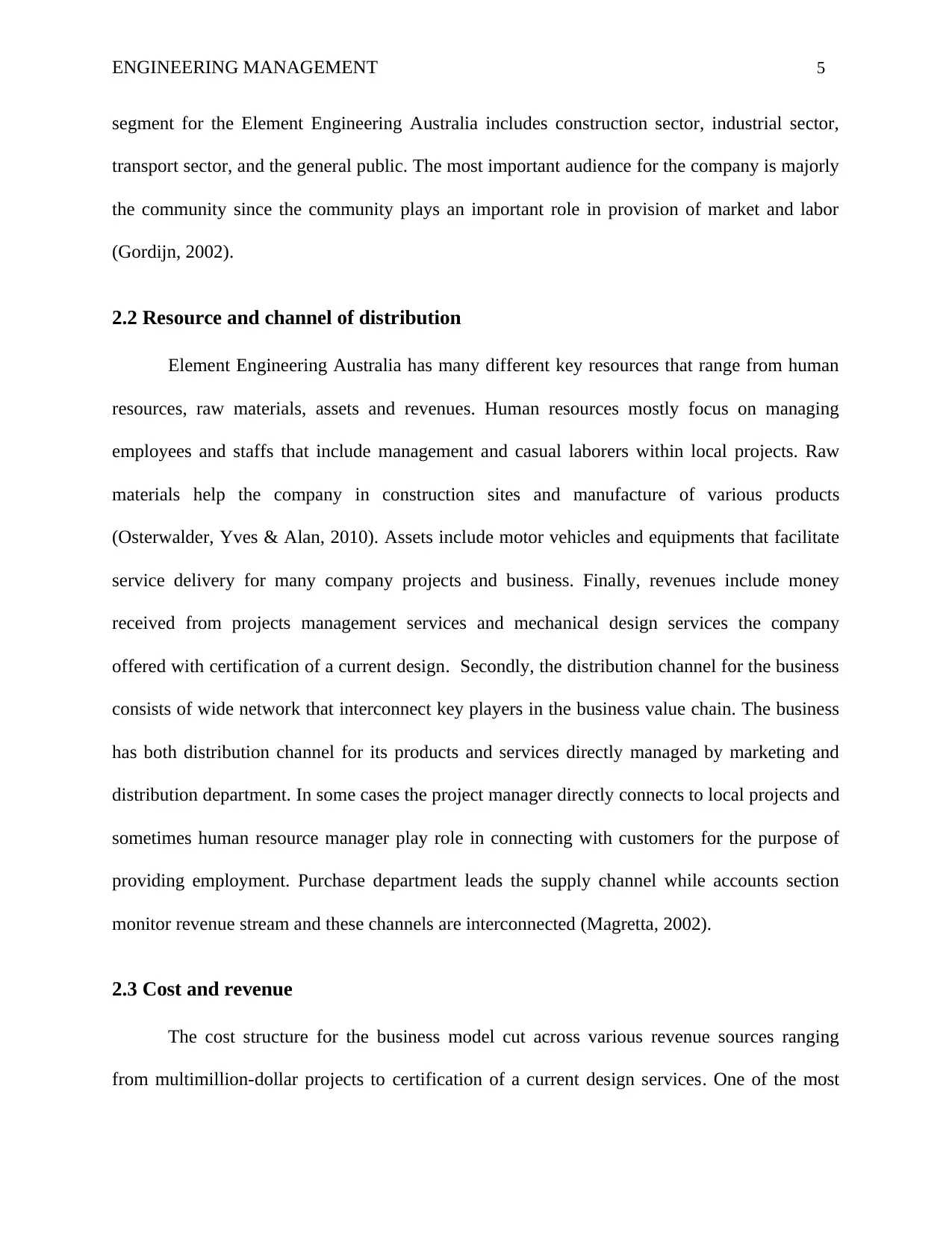
ENGINEERING MANAGEMENT 5
segment for the Element Engineering Australia includes construction sector, industrial sector,
transport sector, and the general public. The most important audience for the company is majorly
the community since the community plays an important role in provision of market and labor
(Gordijn, 2002).
2.2 Resource and channel of distribution
Element Engineering Australia has many different key resources that range from human
resources, raw materials, assets and revenues. Human resources mostly focus on managing
employees and staffs that include management and casual laborers within local projects. Raw
materials help the company in construction sites and manufacture of various products
(Osterwalder, Yves & Alan, 2010). Assets include motor vehicles and equipments that facilitate
service delivery for many company projects and business. Finally, revenues include money
received from projects management services and mechanical design services the company
offered with certification of a current design. Secondly, the distribution channel for the business
consists of wide network that interconnect key players in the business value chain. The business
has both distribution channel for its products and services directly managed by marketing and
distribution department. In some cases the project manager directly connects to local projects and
sometimes human resource manager play role in connecting with customers for the purpose of
providing employment. Purchase department leads the supply channel while accounts section
monitor revenue stream and these channels are interconnected (Magretta, 2002).
2.3 Cost and revenue
The cost structure for the business model cut across various revenue sources ranging
from multimillion-dollar projects to certification of a current design services. One of the most
segment for the Element Engineering Australia includes construction sector, industrial sector,
transport sector, and the general public. The most important audience for the company is majorly
the community since the community plays an important role in provision of market and labor
(Gordijn, 2002).
2.2 Resource and channel of distribution
Element Engineering Australia has many different key resources that range from human
resources, raw materials, assets and revenues. Human resources mostly focus on managing
employees and staffs that include management and casual laborers within local projects. Raw
materials help the company in construction sites and manufacture of various products
(Osterwalder, Yves & Alan, 2010). Assets include motor vehicles and equipments that facilitate
service delivery for many company projects and business. Finally, revenues include money
received from projects management services and mechanical design services the company
offered with certification of a current design. Secondly, the distribution channel for the business
consists of wide network that interconnect key players in the business value chain. The business
has both distribution channel for its products and services directly managed by marketing and
distribution department. In some cases the project manager directly connects to local projects and
sometimes human resource manager play role in connecting with customers for the purpose of
providing employment. Purchase department leads the supply channel while accounts section
monitor revenue stream and these channels are interconnected (Magretta, 2002).
2.3 Cost and revenue
The cost structure for the business model cut across various revenue sources ranging
from multimillion-dollar projects to certification of a current design services. One of the most
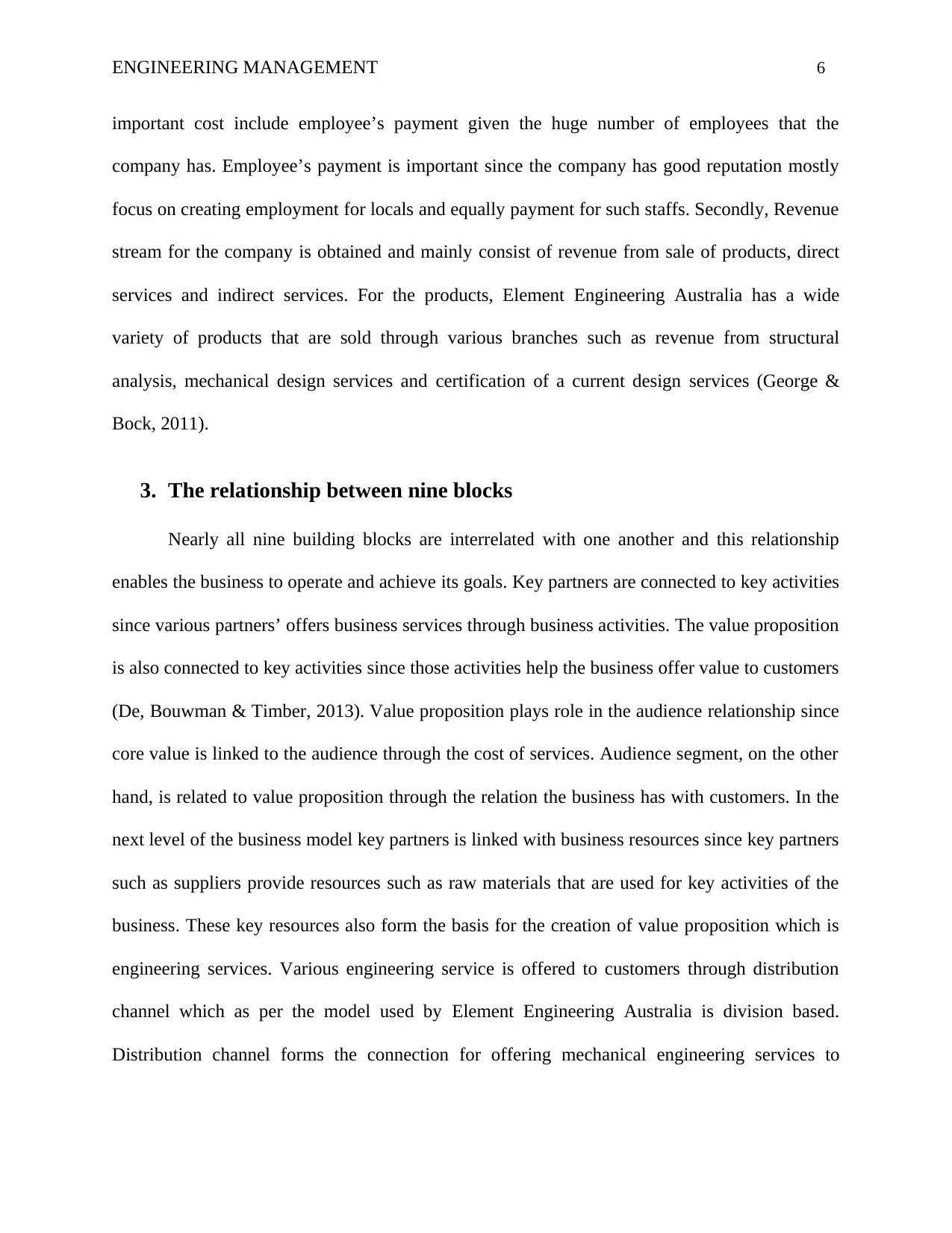
ENGINEERING MANAGEMENT 6
important cost include employee’s payment given the huge number of employees that the
company has. Employee’s payment is important since the company has good reputation mostly
focus on creating employment for locals and equally payment for such staffs. Secondly, Revenue
stream for the company is obtained and mainly consist of revenue from sale of products, direct
services and indirect services. For the products, Element Engineering Australia has a wide
variety of products that are sold through various branches such as revenue from structural
analysis, mechanical design services and certification of a current design services (George &
Bock, 2011).
3. The relationship between nine blocks
Nearly all nine building blocks are interrelated with one another and this relationship
enables the business to operate and achieve its goals. Key partners are connected to key activities
since various partners’ offers business services through business activities. The value proposition
is also connected to key activities since those activities help the business offer value to customers
(De, Bouwman & Timber, 2013). Value proposition plays role in the audience relationship since
core value is linked to the audience through the cost of services. Audience segment, on the other
hand, is related to value proposition through the relation the business has with customers. In the
next level of the business model key partners is linked with business resources since key partners
such as suppliers provide resources such as raw materials that are used for key activities of the
business. These key resources also form the basis for the creation of value proposition which is
engineering services. Various engineering service is offered to customers through distribution
channel which as per the model used by Element Engineering Australia is division based.
Distribution channel forms the connection for offering mechanical engineering services to
important cost include employee’s payment given the huge number of employees that the
company has. Employee’s payment is important since the company has good reputation mostly
focus on creating employment for locals and equally payment for such staffs. Secondly, Revenue
stream for the company is obtained and mainly consist of revenue from sale of products, direct
services and indirect services. For the products, Element Engineering Australia has a wide
variety of products that are sold through various branches such as revenue from structural
analysis, mechanical design services and certification of a current design services (George &
Bock, 2011).
3. The relationship between nine blocks
Nearly all nine building blocks are interrelated with one another and this relationship
enables the business to operate and achieve its goals. Key partners are connected to key activities
since various partners’ offers business services through business activities. The value proposition
is also connected to key activities since those activities help the business offer value to customers
(De, Bouwman & Timber, 2013). Value proposition plays role in the audience relationship since
core value is linked to the audience through the cost of services. Audience segment, on the other
hand, is related to value proposition through the relation the business has with customers. In the
next level of the business model key partners is linked with business resources since key partners
such as suppliers provide resources such as raw materials that are used for key activities of the
business. These key resources also form the basis for the creation of value proposition which is
engineering services. Various engineering service is offered to customers through distribution
channel which as per the model used by Element Engineering Australia is division based.
Distribution channel forms the connection for offering mechanical engineering services to
⊘ This is a preview!⊘
Do you want full access?
Subscribe today to unlock all pages.

Trusted by 1+ million students worldwide
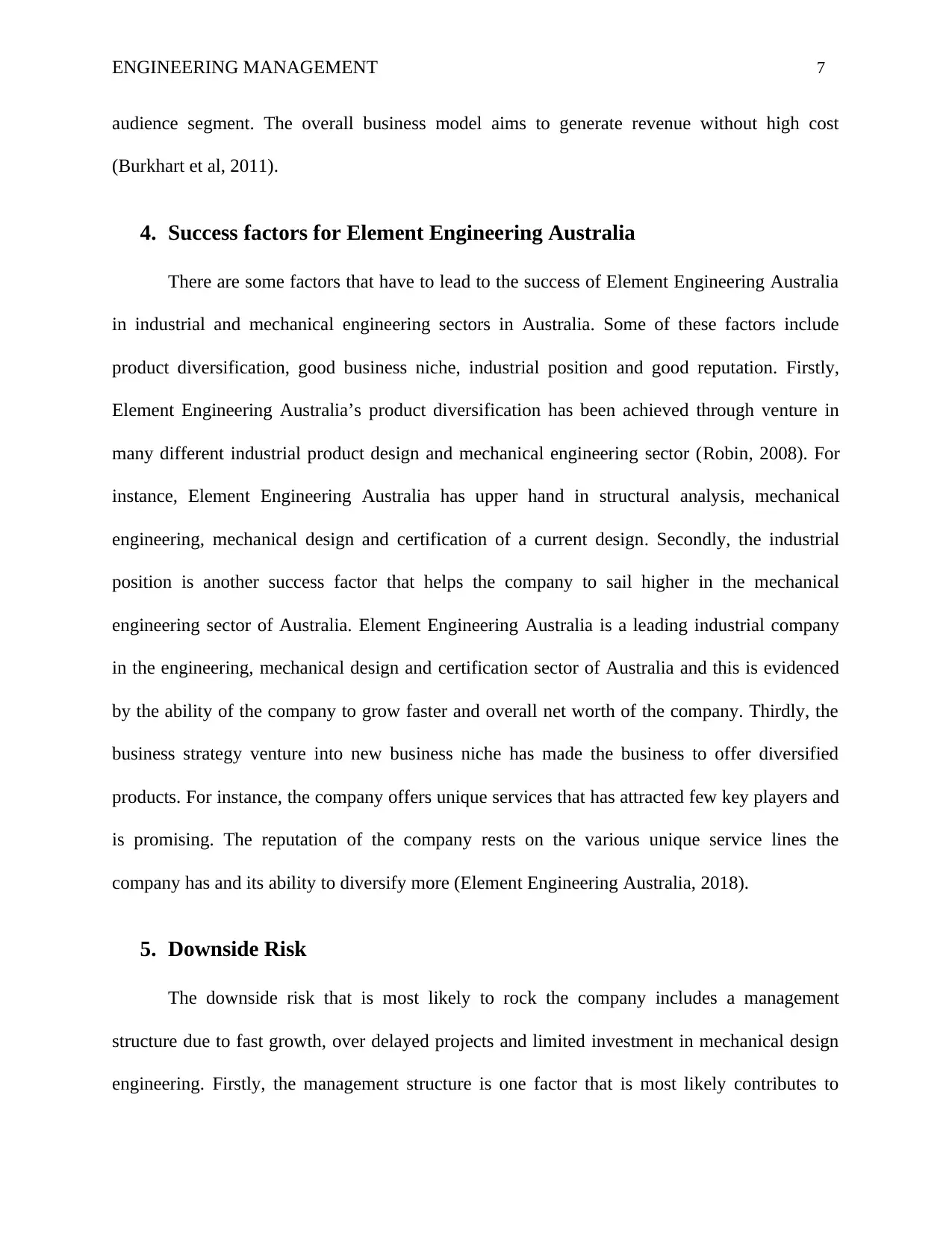
ENGINEERING MANAGEMENT 7
audience segment. The overall business model aims to generate revenue without high cost
(Burkhart et al, 2011).
4. Success factors for Element Engineering Australia
There are some factors that have to lead to the success of Element Engineering Australia
in industrial and mechanical engineering sectors in Australia. Some of these factors include
product diversification, good business niche, industrial position and good reputation. Firstly,
Element Engineering Australia’s product diversification has been achieved through venture in
many different industrial product design and mechanical engineering sector (Robin, 2008). For
instance, Element Engineering Australia has upper hand in structural analysis, mechanical
engineering, mechanical design and certification of a current design. Secondly, the industrial
position is another success factor that helps the company to sail higher in the mechanical
engineering sector of Australia. Element Engineering Australia is a leading industrial company
in the engineering, mechanical design and certification sector of Australia and this is evidenced
by the ability of the company to grow faster and overall net worth of the company. Thirdly, the
business strategy venture into new business niche has made the business to offer diversified
products. For instance, the company offers unique services that has attracted few key players and
is promising. The reputation of the company rests on the various unique service lines the
company has and its ability to diversify more (Element Engineering Australia, 2018).
5. Downside Risk
The downside risk that is most likely to rock the company includes a management
structure due to fast growth, over delayed projects and limited investment in mechanical design
engineering. Firstly, the management structure is one factor that is most likely contributes to
audience segment. The overall business model aims to generate revenue without high cost
(Burkhart et al, 2011).
4. Success factors for Element Engineering Australia
There are some factors that have to lead to the success of Element Engineering Australia
in industrial and mechanical engineering sectors in Australia. Some of these factors include
product diversification, good business niche, industrial position and good reputation. Firstly,
Element Engineering Australia’s product diversification has been achieved through venture in
many different industrial product design and mechanical engineering sector (Robin, 2008). For
instance, Element Engineering Australia has upper hand in structural analysis, mechanical
engineering, mechanical design and certification of a current design. Secondly, the industrial
position is another success factor that helps the company to sail higher in the mechanical
engineering sector of Australia. Element Engineering Australia is a leading industrial company
in the engineering, mechanical design and certification sector of Australia and this is evidenced
by the ability of the company to grow faster and overall net worth of the company. Thirdly, the
business strategy venture into new business niche has made the business to offer diversified
products. For instance, the company offers unique services that has attracted few key players and
is promising. The reputation of the company rests on the various unique service lines the
company has and its ability to diversify more (Element Engineering Australia, 2018).
5. Downside Risk
The downside risk that is most likely to rock the company includes a management
structure due to fast growth, over delayed projects and limited investment in mechanical design
engineering. Firstly, the management structure is one factor that is most likely contributes to
Paraphrase This Document
Need a fresh take? Get an instant paraphrase of this document with our AI Paraphraser
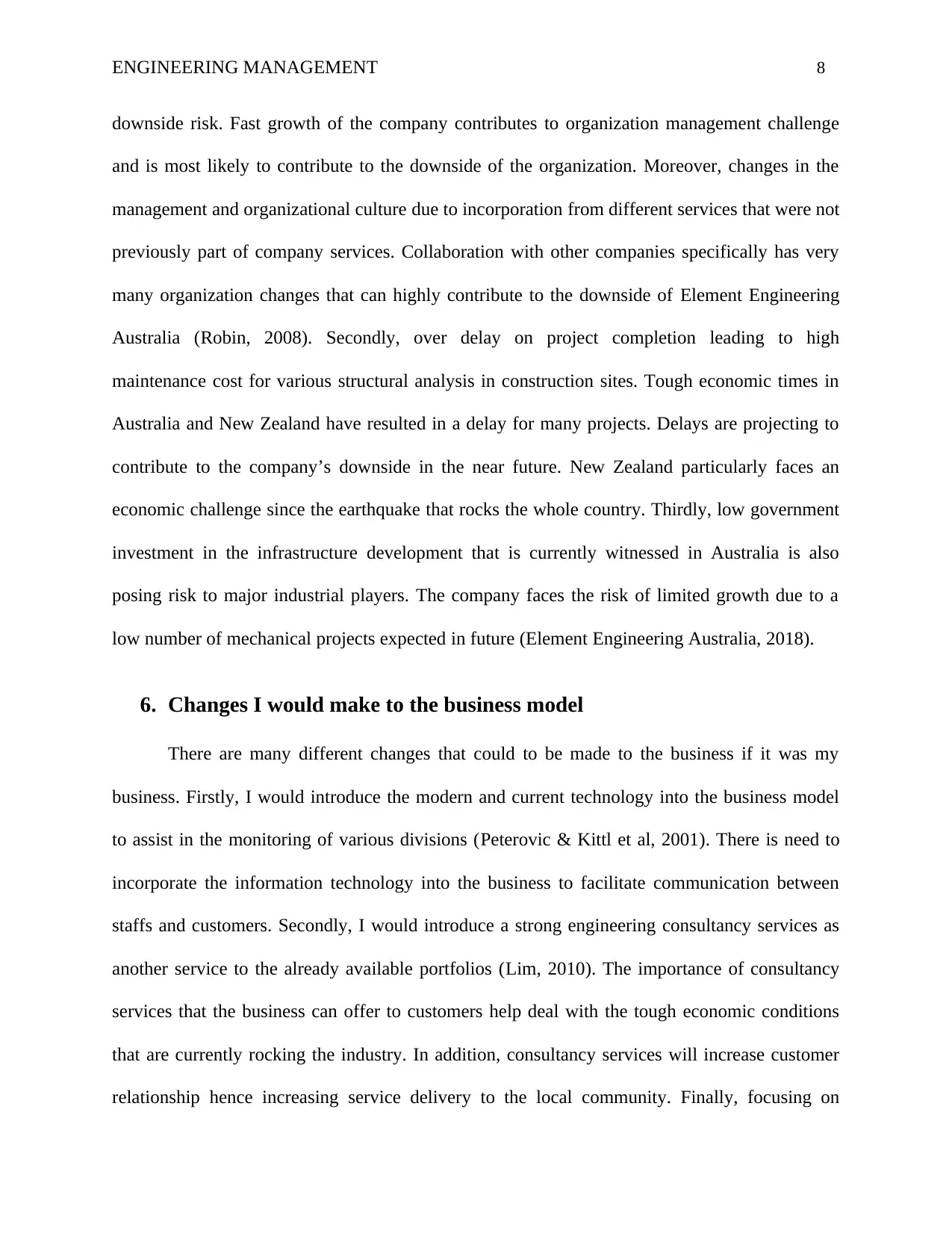
ENGINEERING MANAGEMENT 8
downside risk. Fast growth of the company contributes to organization management challenge
and is most likely to contribute to the downside of the organization. Moreover, changes in the
management and organizational culture due to incorporation from different services that were not
previously part of company services. Collaboration with other companies specifically has very
many organization changes that can highly contribute to the downside of Element Engineering
Australia (Robin, 2008). Secondly, over delay on project completion leading to high
maintenance cost for various structural analysis in construction sites. Tough economic times in
Australia and New Zealand have resulted in a delay for many projects. Delays are projecting to
contribute to the company’s downside in the near future. New Zealand particularly faces an
economic challenge since the earthquake that rocks the whole country. Thirdly, low government
investment in the infrastructure development that is currently witnessed in Australia is also
posing risk to major industrial players. The company faces the risk of limited growth due to a
low number of mechanical projects expected in future (Element Engineering Australia, 2018).
6. Changes I would make to the business model
There are many different changes that could to be made to the business if it was my
business. Firstly, I would introduce the modern and current technology into the business model
to assist in the monitoring of various divisions (Peterovic & Kittl et al, 2001). There is need to
incorporate the information technology into the business to facilitate communication between
staffs and customers. Secondly, I would introduce a strong engineering consultancy services as
another service to the already available portfolios (Lim, 2010). The importance of consultancy
services that the business can offer to customers help deal with the tough economic conditions
that are currently rocking the industry. In addition, consultancy services will increase customer
relationship hence increasing service delivery to the local community. Finally, focusing on
downside risk. Fast growth of the company contributes to organization management challenge
and is most likely to contribute to the downside of the organization. Moreover, changes in the
management and organizational culture due to incorporation from different services that were not
previously part of company services. Collaboration with other companies specifically has very
many organization changes that can highly contribute to the downside of Element Engineering
Australia (Robin, 2008). Secondly, over delay on project completion leading to high
maintenance cost for various structural analysis in construction sites. Tough economic times in
Australia and New Zealand have resulted in a delay for many projects. Delays are projecting to
contribute to the company’s downside in the near future. New Zealand particularly faces an
economic challenge since the earthquake that rocks the whole country. Thirdly, low government
investment in the infrastructure development that is currently witnessed in Australia is also
posing risk to major industrial players. The company faces the risk of limited growth due to a
low number of mechanical projects expected in future (Element Engineering Australia, 2018).
6. Changes I would make to the business model
There are many different changes that could to be made to the business if it was my
business. Firstly, I would introduce the modern and current technology into the business model
to assist in the monitoring of various divisions (Peterovic & Kittl et al, 2001). There is need to
incorporate the information technology into the business to facilitate communication between
staffs and customers. Secondly, I would introduce a strong engineering consultancy services as
another service to the already available portfolios (Lim, 2010). The importance of consultancy
services that the business can offer to customers help deal with the tough economic conditions
that are currently rocking the industry. In addition, consultancy services will increase customer
relationship hence increasing service delivery to the local community. Finally, focusing on
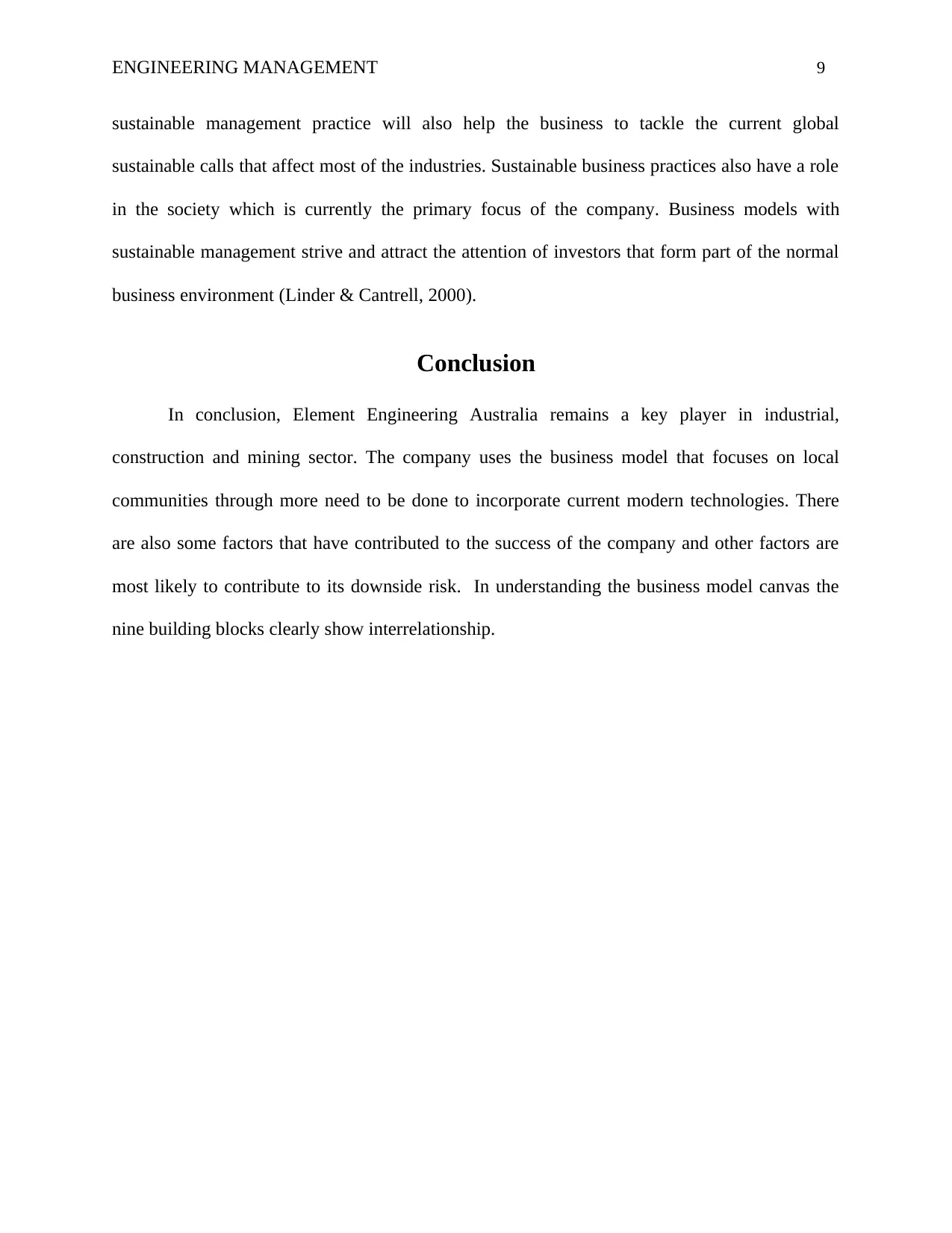
ENGINEERING MANAGEMENT 9
sustainable management practice will also help the business to tackle the current global
sustainable calls that affect most of the industries. Sustainable business practices also have a role
in the society which is currently the primary focus of the company. Business models with
sustainable management strive and attract the attention of investors that form part of the normal
business environment (Linder & Cantrell, 2000).
Conclusion
In conclusion, Element Engineering Australia remains a key player in industrial,
construction and mining sector. The company uses the business model that focuses on local
communities through more need to be done to incorporate current modern technologies. There
are also some factors that have contributed to the success of the company and other factors are
most likely to contribute to its downside risk. In understanding the business model canvas the
nine building blocks clearly show interrelationship.
sustainable management practice will also help the business to tackle the current global
sustainable calls that affect most of the industries. Sustainable business practices also have a role
in the society which is currently the primary focus of the company. Business models with
sustainable management strive and attract the attention of investors that form part of the normal
business environment (Linder & Cantrell, 2000).
Conclusion
In conclusion, Element Engineering Australia remains a key player in industrial,
construction and mining sector. The company uses the business model that focuses on local
communities through more need to be done to incorporate current modern technologies. There
are also some factors that have contributed to the success of the company and other factors are
most likely to contribute to its downside risk. In understanding the business model canvas the
nine building blocks clearly show interrelationship.
⊘ This is a preview!⊘
Do you want full access?
Subscribe today to unlock all pages.

Trusted by 1+ million students worldwide
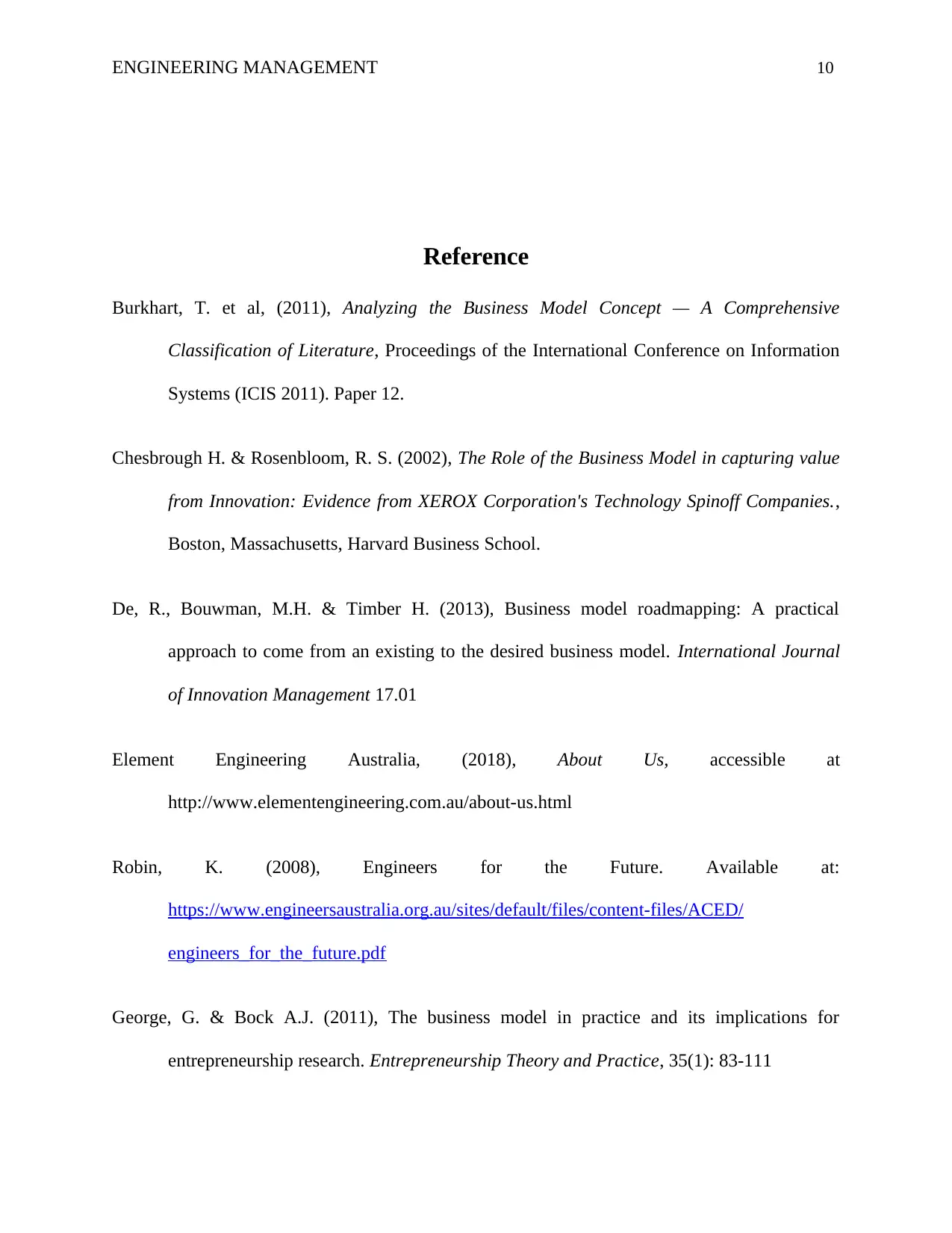
ENGINEERING MANAGEMENT 10
Reference
Burkhart, T. et al, (2011), Analyzing the Business Model Concept — A Comprehensive
Classification of Literature, Proceedings of the International Conference on Information
Systems (ICIS 2011). Paper 12.
Chesbrough H. & Rosenbloom, R. S. (2002), The Role of the Business Model in capturing value
from Innovation: Evidence from XEROX Corporation's Technology Spinoff Companies.,
Boston, Massachusetts, Harvard Business School.
De, R., Bouwman, M.H. & Timber H. (2013), Business model roadmapping: A practical
approach to come from an existing to the desired business model. International Journal
of Innovation Management 17.01
Element Engineering Australia, (2018), About Us, accessible at
http://www.elementengineering.com.au/about-us.html
Robin, K. (2008), Engineers for the Future. Available at:
https://www.engineersaustralia.org.au/sites/default/files/content-files/ACED/
engineers_for_the_future.pdf
George, G. & Bock A.J. (2011), The business model in practice and its implications for
entrepreneurship research. Entrepreneurship Theory and Practice, 35(1): 83-111
Reference
Burkhart, T. et al, (2011), Analyzing the Business Model Concept — A Comprehensive
Classification of Literature, Proceedings of the International Conference on Information
Systems (ICIS 2011). Paper 12.
Chesbrough H. & Rosenbloom, R. S. (2002), The Role of the Business Model in capturing value
from Innovation: Evidence from XEROX Corporation's Technology Spinoff Companies.,
Boston, Massachusetts, Harvard Business School.
De, R., Bouwman, M.H. & Timber H. (2013), Business model roadmapping: A practical
approach to come from an existing to the desired business model. International Journal
of Innovation Management 17.01
Element Engineering Australia, (2018), About Us, accessible at
http://www.elementengineering.com.au/about-us.html
Robin, K. (2008), Engineers for the Future. Available at:
https://www.engineersaustralia.org.au/sites/default/files/content-files/ACED/
engineers_for_the_future.pdf
George, G. & Bock A.J. (2011), The business model in practice and its implications for
entrepreneurship research. Entrepreneurship Theory and Practice, 35(1): 83-111
Paraphrase This Document
Need a fresh take? Get an instant paraphrase of this document with our AI Paraphraser
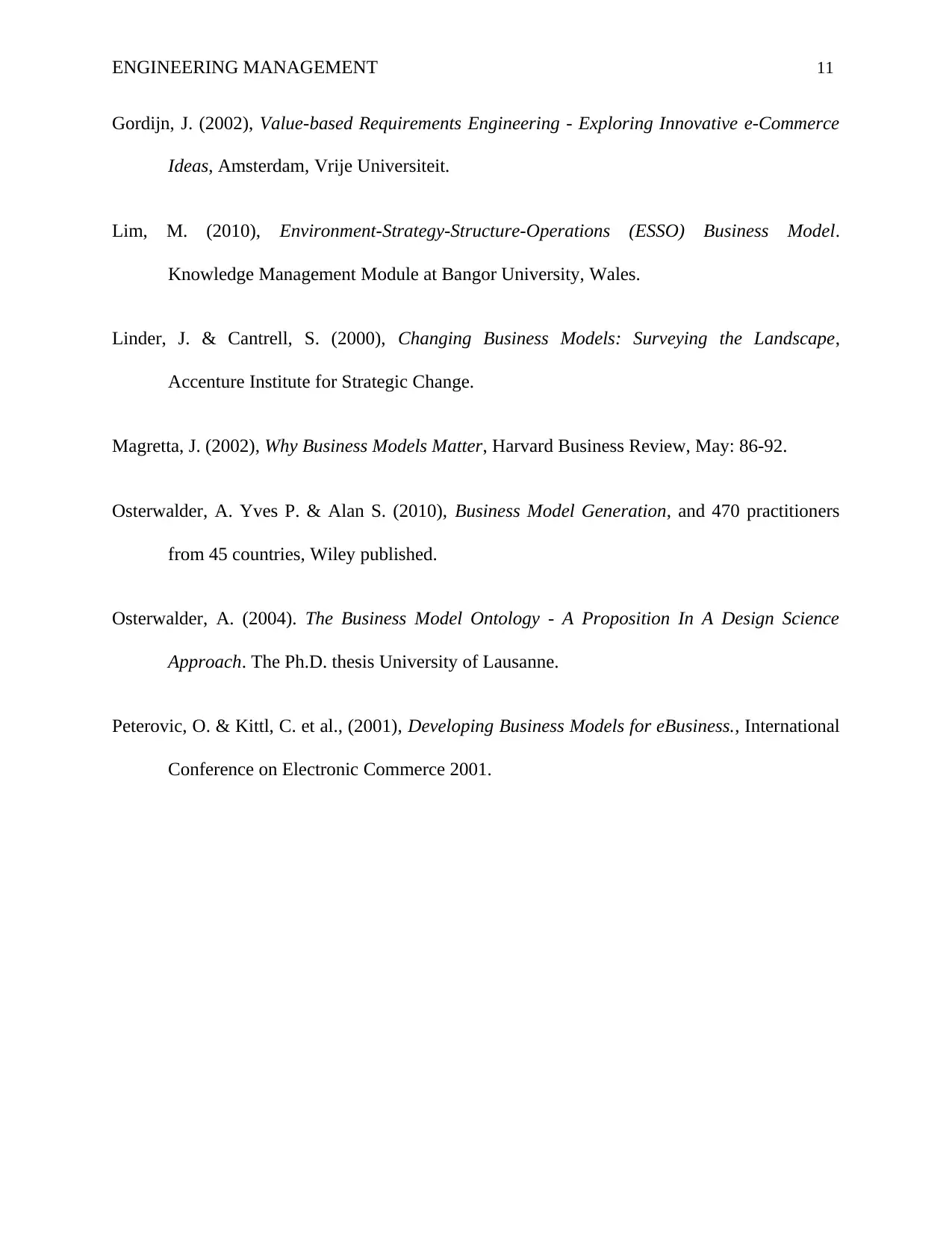
ENGINEERING MANAGEMENT 11
Gordijn, J. (2002), Value-based Requirements Engineering - Exploring Innovative e-Commerce
Ideas, Amsterdam, Vrije Universiteit.
Lim, M. (2010), Environment-Strategy-Structure-Operations (ESSO) Business Model.
Knowledge Management Module at Bangor University, Wales.
Linder, J. & Cantrell, S. (2000), Changing Business Models: Surveying the Landscape,
Accenture Institute for Strategic Change.
Magretta, J. (2002), Why Business Models Matter, Harvard Business Review, May: 86-92.
Osterwalder, A. Yves P. & Alan S. (2010), Business Model Generation, and 470 practitioners
from 45 countries, Wiley published.
Osterwalder, A. (2004). The Business Model Ontology - A Proposition In A Design Science
Approach. The Ph.D. thesis University of Lausanne.
Peterovic, O. & Kittl, C. et al., (2001), Developing Business Models for eBusiness., International
Conference on Electronic Commerce 2001.
Gordijn, J. (2002), Value-based Requirements Engineering - Exploring Innovative e-Commerce
Ideas, Amsterdam, Vrije Universiteit.
Lim, M. (2010), Environment-Strategy-Structure-Operations (ESSO) Business Model.
Knowledge Management Module at Bangor University, Wales.
Linder, J. & Cantrell, S. (2000), Changing Business Models: Surveying the Landscape,
Accenture Institute for Strategic Change.
Magretta, J. (2002), Why Business Models Matter, Harvard Business Review, May: 86-92.
Osterwalder, A. Yves P. & Alan S. (2010), Business Model Generation, and 470 practitioners
from 45 countries, Wiley published.
Osterwalder, A. (2004). The Business Model Ontology - A Proposition In A Design Science
Approach. The Ph.D. thesis University of Lausanne.
Peterovic, O. & Kittl, C. et al., (2001), Developing Business Models for eBusiness., International
Conference on Electronic Commerce 2001.
1 out of 11
Related Documents
Your All-in-One AI-Powered Toolkit for Academic Success.
+13062052269
info@desklib.com
Available 24*7 on WhatsApp / Email
![[object Object]](/_next/static/media/star-bottom.7253800d.svg)
Unlock your academic potential
Copyright © 2020–2025 A2Z Services. All Rights Reserved. Developed and managed by ZUCOL.





